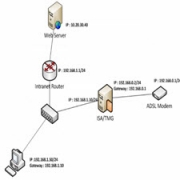An energy efficient approach to extend network life time of wireless sensor networks
ABSTRACT
The energy consumption in wireless sensor networks is a significant matter and there are many ways to conserve energy. The use of mobile sensors is of great relevance to minimize the total energy dissipation in communication and overhead control packets. In a WSN, sensor nodes deliver sensed data back to the sink via multi hopping. The sensor nodes near the sink will usually consume more battery power than others; consequently, these nodes will quickly drain out their battery energy and decrease in the network lifetime of the WSN. The presence of mobilesinks causes increased energy reduction in their proximity, due to more relay load under multi hop communication. Moreover, node deployment technique can also be used to improve the life time of the network. Performance comparisons have been done by simulations between different routing protocols and our approach show efficient results.
INTRODUCTION
Wireless sensor network, sensor nodes send the sensed data back to the sink via multi-hopping. In predetermined deployment, the locations of node are specified .The sensor nodes close to the sink will generally consume more energy than other node leading to a phenomena known as energy hole problem. Therefore shorten the network lifetime of the WSN. The presence of mobile sinks causes less energy consumption in their proximity. So, node deployment technique can also be used to improve the life time of the network. Network lifetime can be defined as the time from the start of network functioning to the instant when the first node in the network runs out of energy .One approach for network lifetime maximization is to reduce node’s transmission power in order to reach their farthest selected neighbour, which not only save energy but can also improve network throughput. However, because of the reducing the transmission range may strongly affect the network connectivity due to the decline of the number of neighbour nodes connected to a given one (called node degree). Another efficient means of conserving energy is to schedule nodes to sleep mode (i.e., turning off their radios) when they are not needed, without changing global connectivity and spatial coverage of the sensing field. The main objective of this research is to investigate the effectiveness of existing approaches as well as our approach for solving energy consumption problem based on Sink mobility and Node deployment strategy.
چکیده
مصرف انرژی در شبکه های حسگر بی سیم یک موضوع مهم است و راه های بسیاری برای صرفه جویی در انرژی وجود دارد. استفاده از سنسورهای موبایل اهمیت زیادی برای کم کردن میزان کل انرژی در بسته های ارتباطی و کنترل بالای سربار دارد. در WSN، گره های حسگر از طریق چند hopping داده های حس شده را به سینک منتقل می کنند. گره های حسگر در نزدیکی سینک معمولا مصرف باتری بیشتری نسبت به دیگران دارند. در نتیجه، این گره ها به سرعت انرژی باتری خود را تخلیه می کنند و در طول عمر شبکه WSN کاهش می یابد. حضور mobilesinks موجب افزایش انرژی در نزدیکی آنها می شود، به دلیل بار بیشتر رله ها تحت ارتباط چند هک. علاوه بر این، روش گسترش شبکه نیز می تواند برای بهبود عمر شبکه استفاده شود. مقایسه های عملکرد با شبیه سازی پروتکل های مختلف مسیریابی انجام شده است و رویکرد ما نتایج کارآمد را نشان می دهد.
مقدمه
شبکه حسگر بی سیم، گره های حسگر از طریق چند hopping داده های حس شده را به سینک منتقل می کند. در استقرار پیش تعیین شده، مکان های گره مشخص می شوند. گره های گره نزدیک به سینک معمولا انرژی بیشتری نسبت به گره های دیگر که منجر به یک پدیده شناخته شده به عنوان مشکل حفره انرژی می شوند، مصرف می کنند. بنابراین طول عمر شبکه WSN را کوتاه کنید. حضور سینک های تلفن همراه باعث کاهش مصرف انرژی در نزدیکی آنها می شود. بنابراین، روش گسترش استقرار گره نیز می تواند برای بهبود طول عمر شبکه مورد استفاده قرار گیرد. طول عمر شبکه می تواند به عنوان زمان شروع فعالیت شبکه تا زمانی که اولین گره در شبکه از انرژی خارج می شود تعریف می شود. یک رویکرد برای افزایش حداکثر طول عمر شبکه، کاهش توان انتقال گره به منظور دستیابی به دورترین همسایه انتخاب شده است. که نه تنها صرفه جویی در انرژی، بلکه همچنین می تواند افزایش توان شبکه را افزایش دهد. با این حال، به علت کاهش محدوده انتقال ممکن است به شدت تحت تاثیر اتصال شبکه به دلیل کاهش تعداد گره های همسایه متصل به یک داده شده (درجه گره نامیده می شود). یکی دیگر از ابزارهای موثر حفاظت از انرژی، برنامه ریزی کردن گره ها به حالت خواب (یعنی خاموش کردن رادیوهایشان) زمانی است که آنها مورد نیاز نیست، بدون تغییر اتصال جهانی و پوشش فضایی میدان حسی. هدف اصلی این پژوهش بررسی اثربخشی رویکردهای موجود و رویکرد ما برای حل مسئله مصرف انرژی بر اساس تحرک سینک و استراتژی استقرار استاد است.
Year: 2016
Publisher : ELSEVIER
By : Veena Ananda , Deepika Agrawala, Preety Tirkeyb, Sudhakar Pandey
File Information: English Language/ 6 Page / size: 394 KB
سال : 1395
ناشر : ELSEVIER
کاری از : Veena Ananda , Deepika Agrawala, Preety Tirkeyb, Sudhakar Pandey
اطلاعات فایل : زبان انگلیسی / 6 صفحه / حجم : KB 394


![An energy efficient approach to extend network life time of[taliem.ir]](https://taliem.ir/wp-content/uploads/An-energy-efficient-approach-to-extend-network-life-time-oftaliem.ir_.jpg)
![An energy efficient approach to extend network life time of[taliem.ir] An energy efficient approach to extend network life time of[taliem.ir]](https://taliem.ir/wp-content/uploads/An-energy-efficient-approach-to-extend-network-life-time-oftaliem.ir_-1.jpg)
![Cluster-head Election using Fuzzy Logic for Wireless Sensor Networks[taliem.ir] Cluster-head Election using Fuzzy Logic for Wireless Sensor Networks[taliem.ir]](https://taliem.ir/wp-content/uploads/Cluster-head-Election-using-Fuzzy-Logic-for-Wireless-Sensor-Networkstaliem.ir_.jpg)

![Lifetime Improvement in Wireless Sensor Networks.[taliem.ir] Lifetime Improvement in Wireless Sensor Networks.[taliem.ir]](https://taliem.ir/wp-content/uploads/Lifetime-Improvement-in-Wireless-Sensor-Networks.taliem.ir_.jpg)


![Sensing, Compression, and Recovery for WSNs[taliem.ir] Sensing, Compression, and Recovery for WSNs[taliem.ir]](https://taliem.ir/wp-content/uploads/Sensing-Compression-and-Recovery-for-WSNstaliem.ir_.jpg)
![ارتباطات اطلاعات حسابداري – شبکه هاي کامپیوتري[taliem.ir] ارتباطات اطلاعات حسابداري - شبکه هاي کامپیوتري[taliem.ir]](https://taliem.ir/wp-content/uploads/ارتباطات-اطلاعات-حسابداري-شبکه-هاي-کامپیوتريtaliem.ir_.jpg)

![حرکت براونی و شبیه سازی فرآیندهای تصادفی با رویکردی کاربردی در[taliem.ir]](https://taliem.ir/wp-content/uploads/حرکت-براونی-و-شبیه-سازی-فرآیندهای-تصادفی-با-رویکردی-کاربردی-درtaliem.ir_-150x150.jpg)
![An expert system hybrid architecture to support experiment[taliem.ir]](https://taliem.ir/wp-content/uploads/An-expert-system-hybrid-architecture-to-support-experimenttaliem.ir_-150x150.jpg)
دیدگاه خود را ثبت کنید
تمایل دارید در گفتگو شرکت کنید؟نظری بدهید!